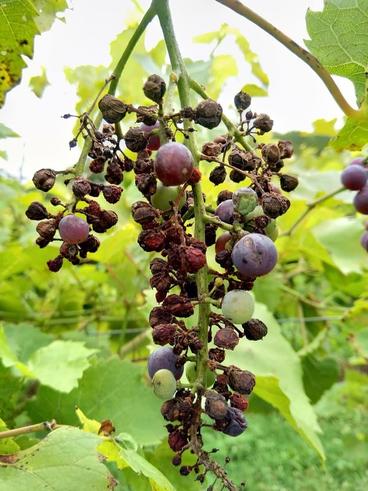Authors: Matt Clark (Assistant Professor) and Annie Klodd (UMN Extension Educator - Fruit Production)

Not all grape bunches are picked or retained at harvest due to low quality attributes including diseases that can reduce wine quality.
Quality is more important than quantity when it comes to wine grapes. First, disease-infected or spoiled grape berries lower the flavor and aroma qualities of the wine. High levels of volatile acidity in wines, attributed to fruit rots, taints the wine and the presence of those compounds are regulated by the government. Secondly, the grower’s reputation is influenced by their ability to deliver healthy, high quality fruit to the winery. Third, some wineries pay growers on a sliding scale based on quality attributes, and many will reject deliveries with defected fruit. For these reasons, it is in the growers’ best interest to only harvest healthy clusters.
We propose that growers and their picking teams adopt the mantra of “when in doubt, throw it out.” We have developed a quick visual "take it or leave it" grape harvest aid PDF (right click to open in a new tab) to assist pickers in making this decision quickly in the field.
However, several questions remain. What should pickers actually do with the clusters when they come across these when picking? Should damaged berries and clusters be dropped to the vineyard floor? Leave them on the vines? Or place them in a separate container for removal from the vineyard? This article aims to answer these questions and discusses best management practices for handling bad clusters in hand-harvested and machine harvested vineyards.
Hand-harvested vineyards:
Scenario 1: Pickers leave bad clusters on the vines. After harvest is complete, someone comes through the vineyard to harvest and dispose of the bad clusters. Alternatively, the bad clusters stay on the vines and are removed during the winter while pruning. Many growers may find this to be the easiest and most effective method.
Scenario 2: Pickers pick the bad clusters and drop them to the ground. The clusters dry up or rot there. The disease-causing pathogens (in particular the fungi that cause black rot) over-winter on the vineyard floor and become active the following season, re-infecting the grapevines. It is better to have the mummies on the floor than left in the canopy. However, complete removal of any bad cluster is preferred.
Scenario 3: Pickers carry “cull buckets” where they place bad clusters, rather than dropping them on the ground. Someone comes through periodically during the harvest to collect the cull buckets and dispose of the bad clusters. This option would effectively remove the diseased clusters from the vineyard, which is preferred. But some growers may find it too time-consuming or cumbersome to carry around the cull buckets.
Machine-harvested vineyards:
Two key approaches are used for quality control when grape harvest is mechanized. Because machine harvest does not discriminate between healthy and infected grape clusters, it is especially important for anyone using a machine harvester to have excellent vineyard disease control to minimize the occurrence of bad clusters prior to harvest. Mummified berries will likely stay on the vine and will need to be removed during pruning to prevent future infections.
Scenario 1: If bad berries are machine harvested, they must be removed post-harvest using a sorting line or table. This equipment can be an expensive investment and ranges from hand sorting to fully automated through computer vision.
Scenario 2: In the absence of a sorting line, vineyard workers should walk through the vineyard prior to harvest, carefully scouting for and removing diseased clusters.
How to dispose of bad clusters:
Vineyard sanitation practices serve to reduce the disease pressure by disrupting the plant disease triangle, by removing diseased plant parts from the vineyard. Harvest is not an exception to this best practice. The diseased clusters should be removed from the vineyard and properly composted to destroy pathogen spores. This should happen away from the winery and vineyard.
Place the diseased fruit in a compost pile and allow them to decompose. During prolonged warm, sunny conditions, compost piles reach interior temperatures sufficient to kill fungi and other microbes. Compost piles should be turned periodically to mix the contents. More information on composting is available here.